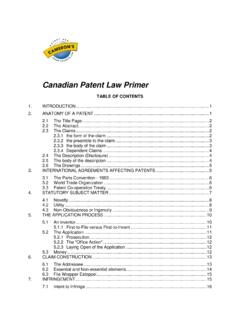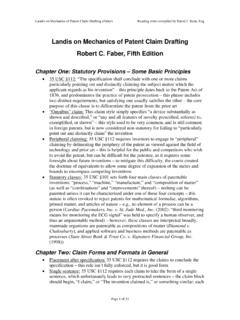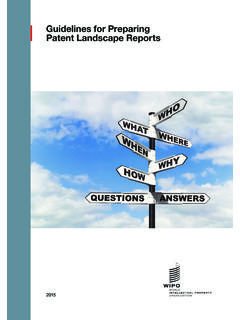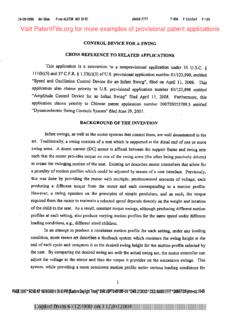Transcription of LED Patent Landscape - iRunway
1 LED Patent Landscape 2014 iRunway , Inc. All rights reserved. Page 2 of 26 Contents 1 Executive Summary .. 3 2 Introduction .. 4 Technology Overview - LED Lighting .. 4 3 Analysis of LED Patent Landscape .. 6 LED Landscape & Classification .. 6 Patent Categories & Distribution .. 6 Top Patent Holders in the LED Landscape .. 7 Analysis of Seminal Patents .. 9 Patent Filing and Grant Trends .. 12 4 LED Display Technology in Mobile Devices .. 13 Display Technology in Mobile Devices .. 13 Samsung & LG .. 15 Future Growth .. 15 5 Other Applications of LED Technology .. 16 6 Key Players in the LED Patent Landscape .. 18 Samsung .. 18 LG .. 19 Philips .. 20 GE .. 21 Cree .. 22 7 Patent Licensing & Litigations in LED .. 23 LED Patent Landscape 2014 iRunway , Inc. All rights reserved. Page 3 of 26 1 Executive Summary The story of David and Goliath unfolded nearly 3,000 years ago, but it is an appropriate description of the current state of the global LED (light-emitting diode) lighting industry.
2 Small niche companies are engaging in fierce competition for shelf space with large global corporations, each one more determined than the next to bring to market the lighting technology of the future. LED lighting stands to benefit from a paradigm shift to household technologies that are sustainable, networked, personalized, and smart. LED lighting is also having a significant impact in diverse areas like residential and commercial lighting, street lighting, and digital communication. Another key application of LED technology is to improve the quality of displays in monitors and mobile devices. Analysts predict an industry growth rate greater than 54% in 2013, reaching $25 billion in annual global sales. In fact, LED technology is expected to play an enormous role in the surging growth of the semiconductor sector during the next several years. On the precipice of a sea change, which companies are positioned to reap the most benefits: David or Goliath?
3 One indicator of future success in the marketplace is the strength of the Patent portfolios owned by the competing companies. This is especially true in the LED lighting industry, where aggressive Patent prosecution, licensing, and litigation practices have become commonplace in recent years. There are currently more than 22,000 granted patents relating to LED technologies, most of which were filed in the last 5-10 years. Major players in the LED industry are currently involved, on an average, in almost three active litigations per company, and in numerous additional licensing agreements. By all appearances, the LED industry s patenting practices have matured even before the technology itself has. This report examines the current LED Patent Landscape and offers analysis of existing Patent holdings of various companies. There are companies, such as Lumileds (now owned by Philips) and Cree that have been heavily involved in R&D activity since the early 2000s.
4 Their Patent portfolios are mid-sized but contain many seminal patents, which increases their value. Then there are global electronics suppliers, like Samsung and LG, which have massive R&D budgets but have only entered the LED lighting market in the last 5 years. Their Patent portfolios are typically large but contain relatively fewer seminal patents. LED Patent Landscape 2014 iRunway , Inc. All rights reserved. Page 4 of 26 2 Introduction Technology Overview - LED Lighting An LED light bulb is a solid state lighting solution designed to be used as a drop-in replacement for incandescent light bulbs, the type used in homes and offices throughout the world. Its main benefits are longevity and energy efficiency, both of which make it a convenient and environmentally friendly lighting choice. Additionally, its small form factor, color-tunability, and connectivity enable new applications that are beyond the capabilities of traditional light bulbs.
5 The technology challenge facing LED manufacturers is that the light emission produced by the LED bulbs has to meet strict requirements in terms of brightness, color, and directionality in order to appear similar to a conventional light bulb. Moreover, all of this has to be accomplished in a cost effective manner, an especially daunting task, considering incumbent incandescent technologies enjoy significant competitive advantages in cost, scale and experience. Adding to the technology challenges facing LED manufacturers is the fact that LED light bulbs are more complex than conventional bulbs. LED light bulbs must contain an assortment of high performance technologies within a small and economical package. In terms of function, LED lighting can be categorized into multiple technology sub-domains. 1. Light emission: The heart of any LED light bulb is the diode, a semiconductor chip that is patterned and connected to electrodes in order to produce light when electrical current is applied.
6 The characteristics of the emitted light depend on the materials and the processes used to manufacture the chip. The most commonly used material in LED chips for lighting applications is gallium nitride (GaN), which emits blue light. Since the early 1990s, numerous advances have been made in GaN film growth (front-end processes such as epitaxy and doping) and processing (back-end processes such as delamination and surface texturing) to boost their light emitting power and efficiency. 2. Light management: The light that emerges from an LED chip is typically unsuitable for many traditional lighting applications. It is often the wrong color (blue rather than white) and emits light with varying intensity in different directions. Advanced phosphor coatings, such as YAG:Ce, have been developed to encapsulate the LED chip or the bulb cover in order to convert the blue light into white light. Reflectors and diffusers are used LED Patent Landscape 2014 iRunway , Inc.
7 All rights reserved. Page 5 of 26 to control the directionality. The combined effect is to make the output of an LED chip resemble the warm, omni-directional light of an incandescent bulb despite the drastically different underlying physics. 3. Heat management: When turned on, an LED chip emits light and heat. Managing the heat is just as important as managing the emitted light to an LED bulb s functionality and performance. Typically, heat is drawn away from the diode using a heat sink made of a conductive material such as aluminum. The material and design of the heat sink, the adhesive material between the LED chip and heat sink, and the air flow around the heat sink can all be engineered and optimized for improved performance and cost. 4. Electronics: The diode requires DC electrical current supply, but the electricity from a wall socket is AC. Therefore, compact, cheap, and accurate AC-DC converters are needed within an LED bulb package.
8 Moreover, many emerging LED products have functionality beyond that of a traditional light bulb, including color-tunability, dimmability, and even networking capabilities. Both power management hardware ( rectifiers, regulators, pulse width modulation (PWM) circuitry for dimming and buck converters) and software running on embedded microprocessors are responsible for optimal and versatile operation of LED lights. LED Patent Landscape 2014 iRunway , Inc. All rights reserved. Page 6 of 26 3 Analysis of LED Patent Landscape LED Landscape & Classification The LED Landscape has been categorized along two dimensions as shown in Figure 1: 1. Technology domains as listed in previous section 2. Applications of LED lighting Figure 1: LED Landscape & Classification Patent Categories & Distribution The breadth and complexity of technologies and applications of LED, and the innovation needed to bring them all together, have resulted in aggressive patenting activity over the years.
9 Based on analysis, around 22,662 patents have been granted in the LED domain 17,869 patents related to LED technology and 4,793 patents related to applications of LED. Table 1 shows the distribution of patents across categories. Level 1 Categories Level 2 Categories Number of Patents Technology domains 17,869 Light Emissions (8,932 patents) Materials 5,153 Front-end Processing 2,158 Back-end Processing 1,621 Electronics (3,878 patents) Power Supply 2,097 Software 1,781 Light Management Directionality 2,522 LED Patent Landscape 2014 iRunway , Inc. All rights reserved. Page 7 of 26 (3,826 patents) Phosphors 1,304 Heat Management (1,233 patents) Air Flow 863 Heat Sinks 370 Applications 4,793 Displays (3,472 patents) Backlit 2,174 Active Matrix 1,298 Lighting (940 patents) Residential 806 Commercial/ Industrial 134 Others (381 patents) Indicators 238 Healthcare 75 Communication 68 Table 1: Level 1 & Level 2 Categories with Number of Granted Patents Significant Patent investments have been made in areas related to LED efficiency, production cost and other key engineering metrics.
10 The light emissions category has 8,932 patents, indicating that much of the innovation in the last decade is related to materials and processing of LED chips. Displays dominate the application of LEDs with 3,472 patents, driven by investments among global electronics manufacturers like Samsung, LG and Panasonic in LED display technology that preceded their push into LED lighting market. Top Patent Holders in the LED Landscape The top companies in the LED Landscape with respect to their portfolio size are: Figure 2: LED Patent Distribution of Top Companies (Source: iRunway analysis based on Patent data from USPTO) 1369737599328321290285264262261040080012 001600No. of PatentsLED Patent Landscape 2014 iRunway , Inc. All rights reserved. Page 8 of 26 Table 2 shows the distribution of patents for the top companies across categories: Company Patent Distribution across Level 1 Categories Technology Application Total Light Emissions Light Management Heat Management Electronics Lighting Display Others Samsung 665 129 18 80 3 469 5 1369 LG 455 68 25 23 4 162 - 737 Philips 212 166 24 115 33 48 1 599 GE 127 116 17 40 13 14 1 328 Osram 120 111 31 31 19 8 1 321 Panasonic 160 50 10 21 15 34 - 290 Kodak 177 23 3 10 3 69 - 285 Cree 120 81 21 8 22 12 - 264 Seiko 195 16 6 5 - 40 - 262 Sony 150 18 3 23 1 65 1 261 Sharp 141 35 5 10 4 63 - 258 AU Optronics 108 26 2 16 0 97 0 249 Hitachi 101 24 9 7 0 83 0 224 Hon Hai 61 42 38 27 11 13 17 209 Semicon Energy 155 6 0 10 0 32 0 203 Table 2.







